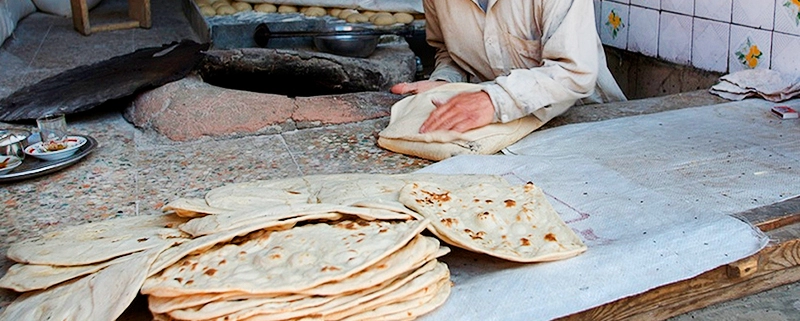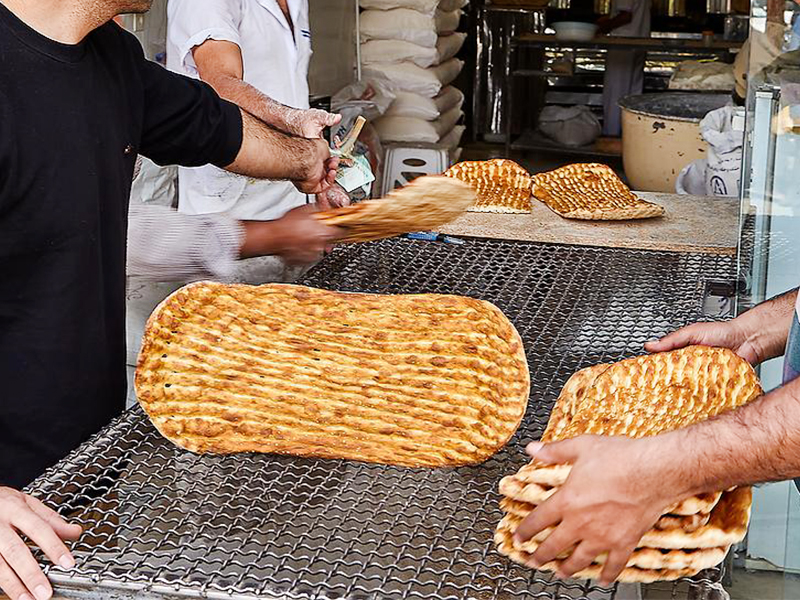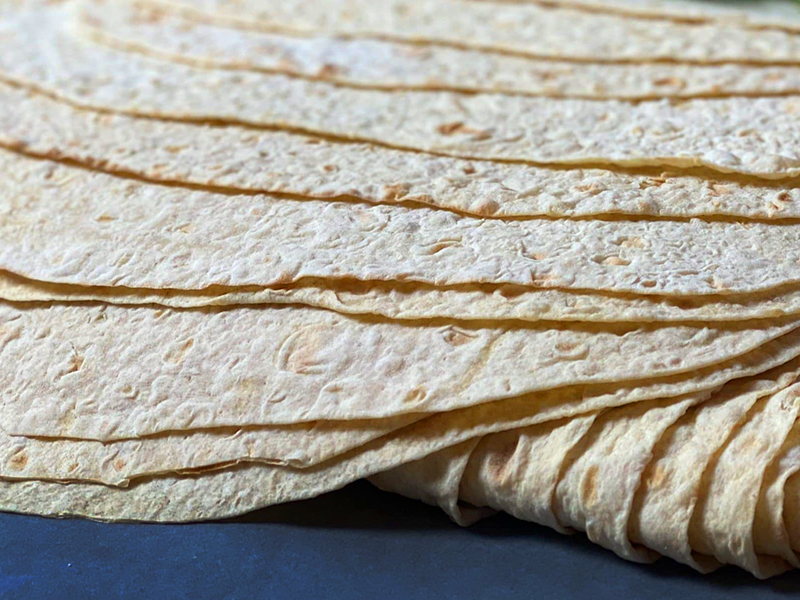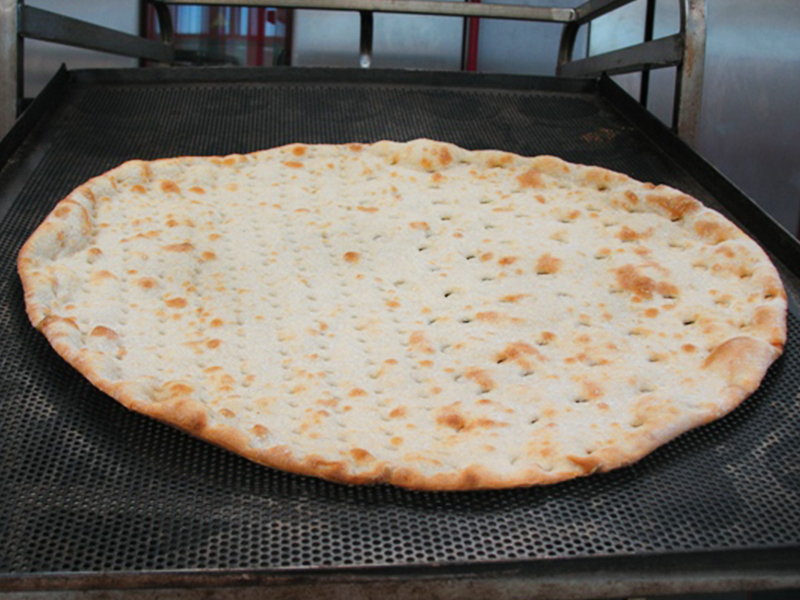Everything About Persian Bread; From Sangak To Barbari
Iranians have always had a special respect for bread for a long time and consider all kinds of bread to be an integral part of their table. Bread holds such significance for Iranians that mornings without it feel like their table is missing something essential. There are two main reasons why traditional Iranian cuisine is closely intertwined with bread: first, Persian bread is the main food of Iranian people, and second, Iran is a country with a lot of ethnic diversity, each of which has deep roots in its soil.
Currently, bread provides 70% of the daily calorie intake for Iranians. The variety of baked breads in Iran among its various ethnic groups is very large and is classified according to different baking methods. Stay with us until the end of this article to learn more about the types of Iranian bread, its preparation, and its ingredients.
Persian Bread History
Historical evidence indicates that grains, especially wheat and barley, were cultivated during the time of the Assyrians, and bread-making was probably popular in Iran from that period onwards. For thousands of years, the main food of Iranians has been wheat bread.
The first signs of bread baking in Iran can be traced to the remains of wheat silos and twin domed ovens in Silk Hill dating from approximately 3000 to 3200 years before the common era. The available evidence also indicates the cultivation of wheat in Jiroft, Kerman, an ancient city with a long history of agriculture.
The cultivation of wheat and its incorporation into various forms of bread shaped the Iranian culinary landscape over different centuries. Iranians invented diverse and unique methods of breadmaking using different types of ovens—sometimes standing, other times placed underground, and occasionally baked in saj or suitable containers. These methods evolved alongside the cultivation of wheat and became integral to Iranian cooking traditions.
Traditional Iranian breads have a rich history and are made with flours from different grains, from wheat to barley and rice. Each type of flour, with its distinct grade and quality, is skillfully kneaded and mixed with leavening ingredients, often shaped using a wooden paddle, and then baked on a cushion-like surface. The evolution of breadmaking in Iran reflects not only represents a historical journey but also the course of the cultural and culinary evolution of the Iranian people.
Bread in Iranian Culture
Bread is not just a food item for Iranians; it is considered a divine blessing that has great value. If bread falls to the ground, it is customary to pick it up, dust it off, and show it respect, as it is viewed as a sacred gift from God. Bread has always been an integral part of Iranian cuisine, maintaining a special place on Iranian dining tables even in the face of increased culinary diversity. Offering bread to others is seen as a gesture of hospitality that is rooted in Iranian tradition.
In Iranian culture, certain terms are associated with bread, which indicates social roles and economic dynamics. “Nan Avar” refers to someone who provides for the economic needs of a family and basically provides their daily bread. On the other hand, “Nan Khor” usually refers to those individuals within the household who benefit from the provisions and economic support provided by the “Nan Avar.” However, “Nan Bor” is a negative term and refers to people whose actions hinder the ability of the “Nan Avar” to work, essentially cutting off the bread and sustenance of a family.
Various expressions related to bread are prevalent in Iranian culture, such as “nan o namak” (bread and salt), “nothing grabs the soul like bread,” or “may no table be without bread.” Proverbs like “bread is the strength of a person’s body” and sayings such as “If there’s no water for me, at least you have bread” further emphasize the significance of bread in Iranian life. Expressions like “eating bread and breaking the salt shaker” or “blind bread” also play a role in conveying cultural nuances associated with this staple food.
Persian Bread Types
Classification of various types of Iranian bread is based on several factors:
- Type of Grain: Different grains such as wheat, barley, corn, rice, lentils, and more are used in preparing various types of bread.
- Bread Volume: Bread is categorized into two main types based on volume—there are hearty breads like “komaaj” and thin ones like “lavash.”
- Composition of Persian bread ingredients: Bread is divided into simple and compound categories based on composition. Simple bread is made solely with flour, while compound bread includes additional nutritious ingredients such as potatoes, vegetables, or meat.
- Baking Method: Bread is further classified based on the baking method, including oven-baked (“tanoori”), flatbread (“komaaji”), stone-baked (“saaji”), and pot-baked (“digi”).
Persian Bread Sangak
Sangak bread, a distinct variety in Persian cuisine, is a thin and flatbread with a thickness ranging from 3 to 5 millimeters and a length of approximately 70 centimeters. Its dough is carefully prepared from specially milled flour, and the bread is baked in a unique oven or kiln composed of a sloping brick shelf covered with hot pebbles. It is worth mentioning that in recent years, urban bakers have started using oil as the primary source of fuel for baking Sangak bread.
The process of baking Sangak involves a minimum of two skilled people: the “khamirgir” (dough handler) and the “shater” (oven tender). The shater stands in front of the oven, smoothing the dough on a slightly convex wooden board called a “sarak,” which is attached to a very long wooden handle. Quickly, the shater inserts the sarak into the oven and drags the dough over the hot pebbles. After a few minutes, the shater or the baker, also known as “nunvaa” (fire handler), lifts the bread using a two-pronged skewer or fork. The complex process of Sangak bread baking involves skill, coordination, and a deep understanding of the traditional techniques passed down through generations.
Persian Flatbread
Persian Flatbread is a staple in Iranian cuisine, famous for its simplicity and versatility. This thin and unleavened bread is prepared from a basic mixture of finely milled flour, water, and sometimes yogurt or milk, which adds a touch of tenderness. The dough is rolled out and then cooked on a hot griddle or in a traditional Tanour. The result is a delicious, flexible flatbread that complements a variety of dishes. Whether enjoyed with stews, used as a wrap for kebabs, or enjoyed on its own, Persian Flatbread has a special place in Iranian meals and includes the culinary traditions passed down through generations.
Persian Bread Lavash
Lavash bread is a traditional Iranian flatbread made from flour, water, leavened dough, and salt, resulting in a very soft, smooth, and thin texture. Sesame seeds or poppy seeds are often sprinkled on top to enhance its flavor. Although lavash bread is prepared differently around the world, the original, traditional version has remained remarkably thin and soft.
Lavash quickly dries when exposed to airflow, giving it a distinctive quality.
Barbari Bread
Barbari bread is one of the most famous traditional Iranian breads, which is very popular because of its exceptional taste. It is a popular breakfast choice paired with cheese, walnuts, and tea, creating a delightful morning meal. Barbari bread, known for its delicious taste, is often among the healthier options in Iranian bread.
Typically made with refined flour, the surface is crunchy and flaky, while the interior has a soft, airy texture. Barbari bread, which is named after the “Barbar” community that settled in the south of Tehran during the Qajar era, has an oval shape with a thickness of 3 to 4 cm and a length of about 70 cm.
Each piece of Berber bread weighing approximately 900 grams is prepared from parts of the yeast dough. Despite its European appearance, Berber bread is baked similarly to Sangak, making it a desirable choice, especially when eaten for breakfast, often accompanied by cheese.
What Is Persian Bread Called?
Persian bread is usually known as “Nan” in Farsi, which is the term for bread in the Persian language. There are various types of Persian bread, each with its own unique characteristics and regional diversity. Some well-known varieties include Barbari, Sangak, Lavash, and Taftoon. These breads can be found in bakeries across Iran and have become an essential part of the Iranian culinary experience. The diverse range of Persian bread reflects the rich cultural and culinary heritage of the region.
How to Eat Persian Bread?
Eating Iranian bread is a pleasurable experience that involves a few simple yet enjoyable steps. The most common way is to tear off a piece of bread by hand into bite-sized portions. Iranians usually accompany their bread with different dishes and use it to cook stew, dip, or spread food. The soft and flexible texture of Persian bread makes it an ideal tool for wrapping around kebabs or other grilled meats, creating a delicious handmade dish.
In traditional Iranian cuisine, a cloth is often placed on the table, and pieces of bread are placed on it, which encourages a communal and shared meal. Bread is considered a versatile companion to almost any meal, enhancing its flavor and providing a satisfying element to a meal.
Persian Bread Oven
The traditional Persian bread oven, known as a “Tanour,” is an essential element in Iranian bakeries. This cylindrical-shaped oven is usually made of clay or brick, and its interior is lined with insulating materials like straw or mud. The unique feature of the Persian bread oven is its sloping, stone-covered shelf, which allows the baker to slide the prepared dough onto the hot stones for baking. This method gives a distinct flavor and texture to the bread. The oven is heated using various fuel sources, including wood and more recently, oil. The art of bread baking in the Persian tanour has been passed down through generations, and it remains a symbol of the rich culinary heritage in Iranian culture.
Persian Bread Recipes
Persian bread recipes showcase a rich combination of flavors and textures, reflecting the diverse culinary traditions of Iran. One popular recipe is the “Persian flatbread recipe,” known for its thin and versatile nature. To prepare this bread, a simple dough is made of finely milled flour and water, sometimes enriched with yogurt or milk for more softness.
The dough is then rolled out and cooked on a hot tray or in a traditional Tanour (oven). The result is a delicious, airy flatbread that pairs well with various dishes or can be enjoyed on its own. The Persian flatbread recipe not only highlights the simplicity of the ingredients but also celebrates the artistry involved in creating a staple that has been a part of Iranian meals for generations.
Persian Bread Calories
Persian bread, a dietary staple for Iranians, is not only cherished for its rich cultural significance but also for its nutritional value. The caloric content of Persian bread varies depending on the type and ingredients used. Generally, a standard serving of Persian bread contributes a moderate amount of calories to daily intake, making it a substantial source of energy.
Whether it is the hearty Barbari or the versatile Lavash, these bread varieties are not only delicious but also provide essential nutrients. Iranians often rely on bread as a significant part of their daily calorie intake, recognizing its importance in maintaining a balanced and nutritious diet.
Final Word
In conclusion, Persian bread has a special place in Iranian culture and tables and is not only a delicious accompaniment to meals but also a symbol of tradition and society. From the thin and versatile Lavash to the lovely Barbari, each type of bread has a unique role in Iranian cuisine.
Whether enjoyed at breakfast with cheese, at lunch with kebabs, or as an integral part of family gatherings, Persian bread is more than just a culinary delight – it is a daily ritual that brings people together. Persian bread, with its diverse flavors, textures, and nutrients, is an authentic example of the rich culinary heritage and the lasting importance it has in the hearts and homes of Iranians.
Are you planning to travel to Iran and looking for an Iran Travel Agency? Check out our Iran tours and Iran food tour.











Leave a Reply
Want to join the discussion?Feel free to contribute!